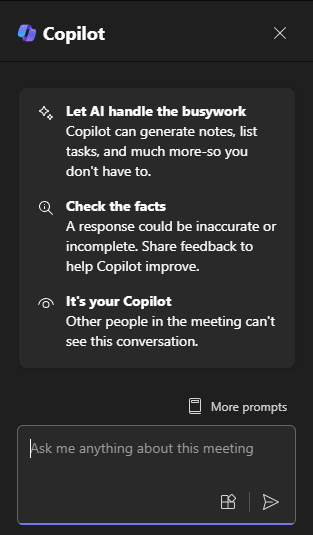Highlight key decisions and actions from Teams meetings
Copilot in Microsoft Teams enhances collaboration and helps you get the most out of your Teams chats and meetings. Quickly recap, identify follow-up tasks, create agendas, and ask questions for more effective and focused meetings. Summarize key takeaways, see what was missed, and pinpoint key people of interest in chat threads you were added to. All without breaking the flow of discussion. Copilot is available in the following meetings and calls:
One-on-one and group calls
Single meetings or scheduled private meetings
Instances or occurrences of meetings in a series
Channel meetings
Meet Now
Copilot in Teams uses your Teams chat and meeting content to generate insights and actionable suggestions alongside your most important Teams touch points. Copilot in Teams is contextual to whatever it is that you're doing. For example, you can access the Copilot pane in a chat, meeting, or call, as long as a few conditions are met:
Transcription or recording is turned on. The meeting organizer can configure the meeting so Copilot works without transcription prior to the meeting.
The meeting or call is long enough for Copilot to analyze. If there isn’t enough transcribed speech in the meeting yet, Copilot states that it needs more information before responding to prompts.
During a meeting or call, select Copilot from the meeting controls. If transcription isn’t already turned on, you'll be asked to turn it on.

Copilot appears in a panel on the right side of the meeting window. Once the meeting is over, select the meeting in your Teams Calendar. From there, select the Recap tab in your meeting details. You can also access the Copilot panel from the meeting recap to ask questions about the meeting.

Let's get crafting
Note
Starting prompt:
Recap this Teams meeting.
In this simple prompt, you start with the basic Goal: to recap a Teams meeting. However, there's no information about why the meeting needs to be summarized or what the summary is needed for.
| Element | Example |
|---|---|
| Basic prompt: Start with a Goal |
Recap this Teams meeting. |
| Good prompt: Add Context |
Adding Context can help Copilot understand the purpose and adjust the response accordingly. "I was late to attend and need a brief overview of the project timeline." |
| Better prompt: Specify Source(s) |
Adding Sources can help Copilot understand which part needs to be summarized and provide a more accurate response. "Did Adele Vance propose any changes?" |
| Best prompt: Set clear Expectations |
Lastly, adding Expectations can help Copilot understand how to format the summary and what level of detail is required. "Include the project timeline in a table and any proposed changes from Adele." |
Note
Crafted prompt:
Recap this Teams meeting. I was late to attend and need a brief overview of the project timeline. Did Adele Vance propose any changes? Include the project timeline in a table and any proposed changes from Adele.
In this prompt, the Goal, Context, Source, and Expectations are all provided, giving Copilot enough direction to generate a response that meets your needs.
Explore more
When you first open Copilot in Teams, you're given some tips for using Copilot and suggested prompts to get you started. Use Copilot to:
List out key points from [a file]
Recap your last meeting
Summarize unread emails from [this person]
Important
Copilot in Teams is available on Windows, Mac, web, Android, and iOS. You must have a Microsoft 365 and a Microsoft 365 Copilot license in order to access Copilot in Teams. For more scenarios on how to use Copilot in Teams meetings, see Get started with Copilot in Microsoft Teams meetings.